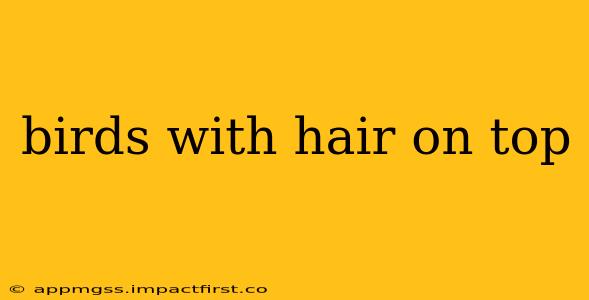The phrase "birds with hair on top" is inherently misleading. Birds don't have hair; they have feathers. However, the unique arrangement and texture of feathers on some bird species' heads can create the illusion of hair, leading to this common misconception. Let's delve into the fascinating world of avian head plumage and explore what gives some birds that seemingly hairy appearance.
What Makes Some Birds Appear to Have "Hair"?
Several factors contribute to the impression of "hair" on a bird's head:
-
Filoplume Feathers: These are thin, hair-like feathers found on many bird species. They're sensory feathers, lacking the barbules that give contour feathers their structure. Filoplumes are often found around the eyes, beak, and on the crown of the head, and they can create a wispy, almost hairy look, especially in certain lighting conditions. Many species, including owls and some songbirds, possess noticeable filoplume feathers.
-
Specialized Head Feathers: Some birds have evolved specialized head feathers that are long, thin, and loosely structured. These feathers can appear shaggy or disheveled, resembling hair. Examples include the erectile crest feathers of certain species of owls or the long, thin feathers framing the faces of some species of parrot.
-
Fluffy Down Feathers: Down feathers are soft, fluffy feathers found beneath the contour feathers. In some species, down feathers on the head may be more visible than on other parts of the body, particularly in chicks or during molting, giving a slightly fuzzy or hairy appearance.
-
Optical Illusions: The way light interacts with the feathers and the overall texture of the plumage can also create the impression of "hair". A bird with sparse feathers on its head in conjunction with other plumage characteristics could appear to have "hair" even if this is not the case.
Do Any Birds Actually Have Hair-Like Structures?
No bird has hair in the mammalian sense. Hair is composed of keratin, just like feathers, but its structure and development are entirely different. Feathers are unique to birds and are far more complex than hair. The resemblance is purely superficial.
What Birds Might Be Mistaken for Having Hair?
Many birds, due to their feather structure and coloration, might be mistaken for having hair. Some examples include:
- Owls: The fluffy feathers and facial disks of owls often give them a somewhat "hairy" look.
- Some Parrot Species: Certain parrot species possess long, thin feathers around their faces, which might be mistaken for hair from a distance.
- Young Birds: The downy feathers of many baby birds can easily be misinterpreted as hair.
It's important to remember that what appears as "hair" is simply a unique adaptation in feather structure and arrangement.
Why Do Birds Have Different Types of Feathers?
Birds' feather diversity is a testament to their remarkable adaptability. Different feather types serve various purposes:
- Contour Feathers: Provide the bird's overall shape and coloration.
- Flight Feathers: Enable flight.
- Down Feathers: Provide insulation.
- Filoplume Feathers: Sensory function.
- Bristles: Protect the eyes and nostrils.
The variation in feather types contributes to the incredible diversity in avian appearance, creating many examples that could be misinterpreted as "hair".
Conclusion:
While the idea of "birds with hair on top" is inaccurate, the diverse structures and textures of bird feathers create a fascinating array of appearances. Understanding the different types of feathers and their functions helps appreciate the beauty and complexity of avian biology. The next time you see a bird with seemingly "hairy" head feathers, remember that it's the remarkable adaptations of its plumage, not actual hair, that's creating that illusion.
